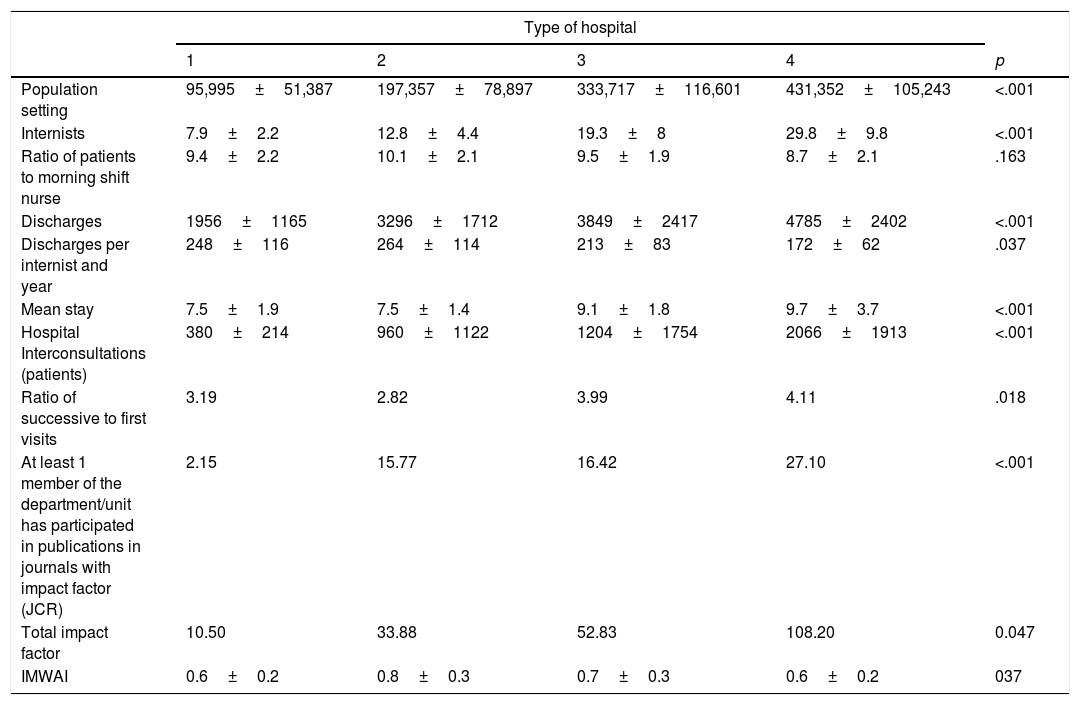To compare the structure, resources and activity of the internal medicine units (IMUs) of the Spanish National Health System (SNHS) in 2013 and 2016. To analyze the differences between IMUs in 2016 by hospital size.
Material and methodsWe conducted a comparison of 2 descriptive cross-sectional studies of IMUs in general acute care hospitals of the Spanish National Health System, with data referring to 2013 and 2016. The variables were collected via an ad hoc questionnaire (RECALMIN survey).
ResultsBetween 2013 and 2016, the demand for care increased dramatically (with an annual average of 11% in hospital discharges and 16% in first consultations), and comorbidity slightly increased (2%). During this period, the mean productivity of IMUs increased 16.7% (0.6±0.3 vs. 0.7±0.3; p=.09), and the mean stay decreased 10% (9±2.2 vs. 8.1±2.1 days; p=.001). Progress in implementing good practices and systematic care for complex chronic patients was scarce. Both surveys found variability among IMUs and marked differences among IMUs of hospitals of different sizes.
ConclusionsIMUs responded to the increased burden of care they supported during 2013–2016 by improving their efficiency and productivity; however, advances in implementing good practices, including care for chronic complex patients, were scare. The significant variability in the indicators of structure, activity and management models found in 2013 remained in 2016.
Comparar la estructura, recursos y actividad de las Unidades de Medicina Interna (UMI) del Sistema Nacional de Salud (SNS) en 2013 y 2016. Analizar las diferencias entre UMI en 2016 por tamaño de hospital.
Material y métodosComparativa de 2 estudios descriptivos transversales de UMI en hospitales generales de agudos del Sistema Nacional de Salud con datos referidos a 2013 y a 2016. Las variables fueron recogidas mediante un cuestionario «ad hoc» (encuesta RECALMIN).
ResultadosEntre 2013 y 2016 aumentó notablemente la demanda asistencial (con un promedio anual del 11% en altas de hospitalización y del 16% en primeras consultas) y ligeramente la comorbilidad (2%). En el mismo período, aumentó un 16,7% la productividad media de las UMI (0,6±0,3 vs. 0,7±0,3; p=0,09) y la estancia media disminuyó un 10% (9±2,2 vs. 8,1±2,1 días; p=0,001). Los progresos en la implantación de buenas prácticas y de una atención sistemática al paciente crónico complejo fueron escasos. La variabilidad entre UMI y las notables diferencias entre UMI de hospitales de tamaño distinto fueron hallazgos de ambas encuestas.
ConclusionesLas UMI respondieron al aumento de la carga asistencial que soportaron en el período 2013-2016 mejorando su eficiencia y productividad, pero los avances en la implantación de buenas prácticas, incluyendo la atención al paciente crónico complejo, fueron escasos. La importante variabilidad en los indicadores de estructura, actividad y modelos de gestión encontrada en 2013 se mantuvo en 2016.
Article
Diríjase desde aquí a la web de la >>>FESEMI<<< e inicie sesión mediante el formulario que se encuentra en la barra superior, pulsando sobre el candado.

Una vez autentificado, en la misma web de FESEMI, en el menú superior, elija la opción deseada.

>>>FESEMI<<<










